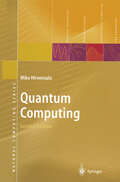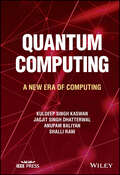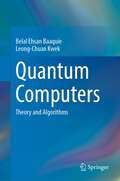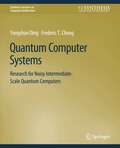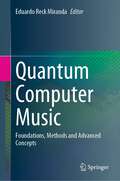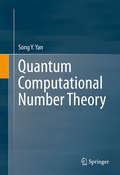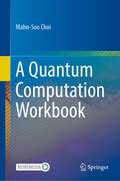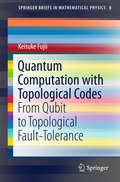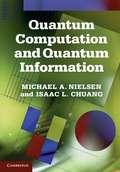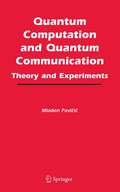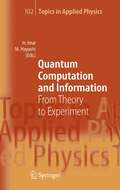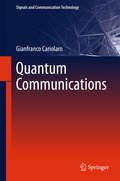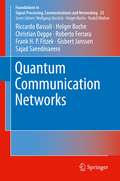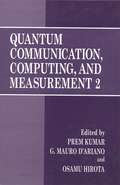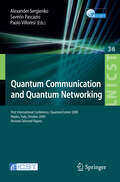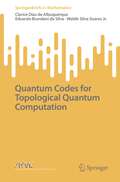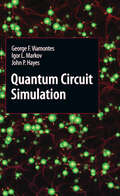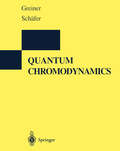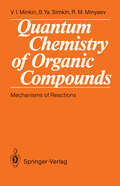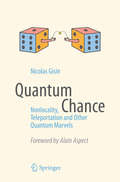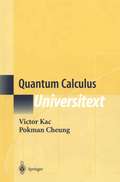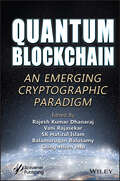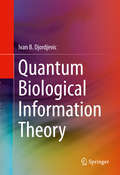- Table View
- List View
Quantum Computing (Natural Computing Series)
by Mika HirvensaloMika Hirvensalo maps out the new multidisciplinary research area of quantum computing. The text contains an introduction to quantum computing as well as the most important recent results on the topic. The presentation is uniform and computer science-oriented. Thus, the book differs from most of the previous ones which are mainly physics-oriented. The special style of presentation makes the theory of quantum computing accessible to a larger audience. Many examples and exercises ease the understanding. In this second edition, a new chapter on quantum information has been added and numerous corrections, amendments, and extensions have been incorporated throughout the entire text.
Quantum Computing: A New Era of Computing
by Kuldeep Singh Kaswan Jagjit Singh Dhatterwal Anupam Baliyan Shalli RaniQUANTUM COMPUTING A helpful introduction to all aspects of quantum computing Quantum computing is a field combining quantum mechanics—the physical science of nature at the scale of atoms and subatomic particles—and information science. Where ordinary computing uses bits, logical values whose position can either be 0 or 1, quantum computing is built around qubits, a fundamental unit of quantum information which can exist in a superposition of both states. As quantum computers are able to complete certain kinds of functions more accurately and efficiently than computers built on classical binary logic, quantum computing is an emerging frontier which promises to revolutionize information science and its applications. This book provides a concise, accessible introduction to quantum computing. It begins by introducing the essentials of quantum mechanics that information and computer scientists require, before moving to detailed discussions of quantum computing in theory and practice. As quantum computing becomes an ever-greater part of the global information technology landscape, the knowledge in Quantum Computing will position readers to join a vital and highly marketable field of research and development. The book’s readers will also find: Detailed diagrams and illustrations throughout A broadly applicable quantum algorithm that improves on the best-known classical algorithms for a wide range of problems In-depth discussion of essential topics including key distribution, cluster state quantum computing, superconducting qubits, and more Quantum Computing is perfect for advanced undergraduate and graduate students in computer science, engineering, mathematics, or the physical sciences, as well as for researchers and academics at the intersection of these fields who want a concise reference.
Quantum Computing: A New Era of Computing
by Kuldeep Singh Kaswan Jagjit Singh Dhatterwal Anupam Baliyan Shalli RaniQUANTUM COMPUTING A helpful introduction to all aspects of quantum computing Quantum computing is a field combining quantum mechanics—the physical science of nature at the scale of atoms and subatomic particles—and information science. Where ordinary computing uses bits, logical values whose position can either be 0 or 1, quantum computing is built around qubits, a fundamental unit of quantum information which can exist in a superposition of both states. As quantum computers are able to complete certain kinds of functions more accurately and efficiently than computers built on classical binary logic, quantum computing is an emerging frontier which promises to revolutionize information science and its applications. This book provides a concise, accessible introduction to quantum computing. It begins by introducing the essentials of quantum mechanics that information and computer scientists require, before moving to detailed discussions of quantum computing in theory and practice. As quantum computing becomes an ever-greater part of the global information technology landscape, the knowledge in Quantum Computing will position readers to join a vital and highly marketable field of research and development. The book’s readers will also find: Detailed diagrams and illustrations throughout A broadly applicable quantum algorithm that improves on the best-known classical algorithms for a wide range of problems In-depth discussion of essential topics including key distribution, cluster state quantum computing, superconducting qubits, and more Quantum Computing is perfect for advanced undergraduate and graduate students in computer science, engineering, mathematics, or the physical sciences, as well as for researchers and academics at the intersection of these fields who want a concise reference.
Quantum Computers: Theory and Algorithms
by Belal Ehsan Baaquie Leong-Chuan KwekThis book presents various theories and algorithms to create a quantum computer. The concept of the classical and quantum computers, and the concept of circuits and gates are reviewed. The example of the Deutsch and the Deutsch-Josca algorithm is discussed to illustrate some key features of quantum computing. The Grover algorithm, considered to be of major milestone of the subject, is discussed in detail to exemplify the techniques used in computer algorithms. The role of quantum superposition (also called quantum parallelism) and of quantum entanglement is discussed in order to understand the key advantages of a quantum over a classical computer.
Quantum Computer Systems: Research for Noisy Intermediate-Scale Quantum Computers (Synthesis Lectures on Computer Architecture)
by Yongshan Ding Frederic T. ChongThis book targets computer scientists and engineers who are familiar with concepts in classical computer systems but are curious to learn the general architecture of quantum computing systems. It gives a concise presentation of this new paradigm of computing from a computer systems' point of view without assuming any background in quantum mechanics. As such, it is divided into two parts. The first part of the book provides a gentle overview on the fundamental principles of the quantum theory and their implications for computing. The second part is devoted to state-of-the-art research in designing practical quantum programs, building a scalable software systems stack, and controlling quantum hardware components. Most chapters end with a summary and an outlook for future directions. This book celebrates the remarkable progress that scientists across disciplines have made in the past decades and reveals what roles computer scientists and engineers can play to enable practical-scale quantum computing.
Quantum Computer Music: Foundations, Methods and Advanced Concepts
by Eduardo Reck MirandaThis book explores music with respect to quantum computing, a nascent technology that is advancing rapidly. There is a long history of research into using computers for music since the 1950s. Nowadays, computers are essential for the music economy. Therefore, it is very likely that quantum computers will impact the music industry in the time to come. Consequently, a new area of research and development is emerging: Quantum Computer Music. This unprecedented book presents the new field of Quantum Computer Music. It introduces the fundamentals of quantum computing for musicians and the latest developments by pioneering practitioners.
Quantum Computational Number Theory
by Song Y. YanThis book provides a comprehensive introduction to advanced topics in the computational and algorithmic aspects of number theory, focusing on applications in cryptography. Readers will learn to develop fast algorithms, including quantum algorithms, to solve various classic and modern number theoretic problems. Key problems include prime number generation, primality testing, integer factorization, discrete logarithms, elliptic curve arithmetic, conjecture and numerical verification. The author discusses quantum algorithms for solving the Integer Factorization Problem (IFP), the Discrete Logarithm Problem (DLP), and the Elliptic Curve Discrete Logarithm Problem (ECDLP) and for attacking IFP, DLP and ECDLP based cryptographic systems. Chapters also cover various other quantum algorithms for Pell's equation, principal ideal, unit group, class group, Gauss sums, prime counting function, Riemann's hypothesis and the BSD conjecture.Quantum Computational Number Theory is self-contained and intended to be used either as a graduate text in computing, communications and mathematics, or as a basic reference in the related fields. Number theorists, cryptographers and professionals working in quantum computing, cryptography and network security will find this book a valuable asset.
A Quantum Computation Workbook
by Mahn-Soo ChoiTeaching quantum computation and information is notoriously difficult, because it requires covering subjects from various fields of science, organizing these subjects consistently in a unified way despite their tendency to favor their specific languages, and overcoming the subjects’ abstract and theoretical natures, which offer few examples of actual realizations. In this book, we have organized all the subjects required to understand the principles of quantum computation and information processing in a manner suited to physics, mathematics, and engineering courses as early as undergraduate studies.In addition, we provide a supporting package of quantum simulation software from Wolfram Mathematica, specialists in symbolic calculation software. Throughout the book’s main text, demonstrations are provided that use the software package, allowing the students to deepen their understanding of each subject through self-practice. Readers can change the code so as to experiment with their own ideas and contemplate possible applications. The information in this book reflects many years of experience teaching quantum computation and information. The quantum simulation-based demonstrations and the unified organization of the subjects are both time-tested and have received very positive responses from the students who have experienced them.
Quantum Computation with Topological Codes: From Qubit to Topological Fault-Tolerance (SpringerBriefs in Mathematical Physics #8)
by Keisuke FujiiThis book presents a self-consistent review of quantum computation with topological quantum codes. The book covers everything required to understand topological fault-tolerant quantum computation, ranging from the definition of the surface code to topological quantum error correction and topological fault-tolerant operations. The underlying basic concepts and powerful tools, such as universal quantum computation, quantum algorithms, stabilizer formalism, and measurement-based quantum computation, are also introduced in a self-consistent way. The interdisciplinary fields between quantum information and other fields of physics such as condensed matter physics and statistical physics are also explored in terms of the topological quantum codes. This book thus provides the first comprehensive description of the whole picture of topological quantum codes and quantum computation with them.
Quantum Computation and Quantum Information: 10th Anniversary Edition (PDF)
by Michael A. Nielsen Isaac L. ChuangOne of the most cited books in physics of all time, Quantum Computation and Quantum Information remains the best textbook in this exciting field of science. This 10th anniversary edition includes an introduction from the authors setting the work in context. This comprehensive textbook describes such remarkable effects as fast quantum algorithms, quantum teleportation, quantum cryptography and quantum error-correction. Quantum mechanics and computer science are introduced before moving on to describe what a quantum computer is, how it can be used to solve problems faster than 'classical' computers and its real-world implementation. It concludes with an in-depth treatment of quantum information. Containing a wealth of figures and exercises, this well-known textbook is ideal for courses on the subject, and will interest beginning graduate students and researchers in physics, computer science, mathematics, and electrical engineering.
Quantum Computation and Quantum Communication: Theory and Experiments
by Mladen PavicicThe field of quantum computing has experienced rapid development and many different experimental and theoretical groups have emerged worldwide.This book presents the key elements of quantum computation and communication theories and their implementation in an easy-to-read manner for readers coming from physics, mathematics and computer science backgrounds. Integrating both theoretical aspects and experimental verifications of developing quantum computers, the author explains why particular mathematical methods, physical models and realistic implementations might provide critical steps towards achieving the final goal - constructing quantum computers and quantum networks. The book serves as an excellent introduction for new researchers and also provides a useful review for specialists in the field
Quantum Computation and Information: From Theory to Experiment (Topics in Applied Physics #102)
by Hiroshi Imai Masahito HayashiThis book reviews selected topics charterized by great progress and covers the field from theoretical areas to experimental ones. It contains fundamental areas, quantum query complexity, quantum statistical inference, quantum cloning, quantum entanglement, additivity. It treats three types of quantum security system, quantum public key cryptography, quantum key distribution, and quantum steganography. A photonic system is highlighted for the realization of quantum information processing.
Quantum Communications (Signals and Communication Technology)
by Gianfranco CariolaroThis book demonstrates that a quantum communication system using the coherent light of a laser can achieve performance orders of magnitude superior to classical optical communicationsQuantum Communications provides the Masters and PhD signals or communications student with a complete basics-to-applications course in using the principles of quantum mechanics to provide cutting-edge telecommunications. Assuming only knowledge of elementary probability, complex analysis and optics, the book guides its reader through the fundamentals of vector and Hilbert spaces and the necessary quantum-mechanical ideas, simply formulated in four postulates. A turn to practical matters begins with and is then developed by:development of the concept of quantum decision, emphasizing the optimization of measurements to extract useful information from a quantum system;general formulation of a transmitter–receiver systemparticular treatment of the most popular quantum communications systems—OOK, PPM, PSK and QAM;more realistic performance evaluation introducing thermal noise and system description with density operators;consideration of scarce existing implementations of quantum communications systems and their difficulties with suggestions for future improvement; andseparate treatment of quantum information with discrete and continuous states.Quantum Communications develops the engineering student’s exposure to quantum mechanics and shows physics students that its theories can have practically beneficial application in communications systems. The use of example and exercise questions (together with a downloadable solutions manual for instructors, available from http://extras.springer.com/) will help to make the material presented really sink in for students and invigorate subsequent research.
Quantum Communication Networks (Foundations in Signal Processing, Communications and Networking #23)
by Frank H. Fitzek Holger Boche Christian Deppe Riccardo Bassoli Roberto Ferrara Gisbert Janssen Sajad SaeedinaeeniThis book provides a tutorial on quantum communication networks. The authors discuss current paradigm shifts in communication networks that are needed to add computing and storage to the simple transport ideas of prevailing networks. They show how these ‘softwarized’ solutions break new grounds to reduce latency and increase resilience. The authors discuss how even though these solutions have inherent problems due to introduced computing latency and energy consumption, the problems can be solved by hybrid classical-quantum communication networks. The book brings together quantum networking, quantum information theory, quantum computing, and quantum simulation.
Quantum Communication, Computing, and Measurement 2
by Prem Kumar Osamu Hirota G. Mauro D'ArianoBased on the Fourth International Conference on Quantum Communication, Measurement and Computing, this volume brings together scientists working in the interdisciplinary fields of quantum communication science and technology. Topics include quantum information theory, quantum computing, stochastic processes and filtering, and quantum measurement theory
Quantum Communication and Quantum Networking: First International Conference, QuantumComm 2009, Naples, Italy, October 26-30, 2009, Revised Selected Papers (Lecture Notes of the Institute for Computer Sciences, Social Informatics and Telecommunications Engineering #36)
by Alexander Sergienko Saverio Pascazio Paolo VilloresiQUANTUMCOMM 2009––the International Conference on Quantum Communi- tion and Quantum Networking (from satellite to nanoscale)––took place in Vico Equense near Naples, Italy, during October 26–30, 2009. The conference made a significant step toward stimulating direct dialogue between the communities of quantum physics and quantum information researchers who work with photons, atoms, and electrons in pursuit of the common goal of investigating and utilizing the transfer of physical information between quantum systems. This meeting brought together experts in quantum communication, quantum inf- mation processing, quantum nanoscale physics, quantum photonics, and networking. In the light of traditional approaches to quantum information processing, quantum communication mainly deals with encoding and securely distributing quantum states of light in optical fiber or in free space in order to provide the technical means for quantum cryptography applications. Exciting advances in the area of quantum c- munication over the last decade have made the metropolitan quantum network a re- ity. Several papers presented at this meeting have demonstrated that quantum crypt- raphy is approaching the point of becoming a high-tech application rather than a - search subject. The natural distance limitation of quantum cryptography has been significantly augmented using ideas of global quantum communication with stab- orbit satellites. The results presented at this conference demonstrated that practical secure satellite communication is clearly within reach.
Quantum Codes for Topological Quantum Computation (SpringerBriefs in Mathematics)
by Clarice Dias Albuquerque Eduardo Brandani Silva Waldir Silva Soares Jr.This book offers a structured algebraic and geometric approach to the classification and construction of quantum codes for topological quantum computation. It combines key concepts in linear algebra, algebraic topology, hyperbolic geometry, group theory, quantum mechanics, and classical and quantum coding theory to help readers understand and develop quantum codes for topological quantum computation.One possible approach to building a quantum computer is based on surface codes, operated as stabilizer codes. The surface codes evolved from Kitaev's toric codes, as a means to developing models for topological order by using qubits distributed on the surface of a toroid. A significant advantage of surface codes is their relative tolerance to local errors. A second approach is based on color codes, which are topological stabilizer codes defined on a tessellation with geometrically local stabilizer generators. This book provides basic geometric concepts, like surface geometry, hyperbolic geometry and tessellation, as well as basic algebraic concepts, like stabilizer formalism, for the construction of the most promising classes of quantum error-correcting codes such as surfaces codes and color codes.The book is intended for senior undergraduate and graduate students in Electrical Engineering and Mathematics with an understanding of the basic concepts of linear algebra and quantum mechanics.
Quantum Circuit Simulation
by George F. Viamontes Igor L. Markov John P. HayesQuantum Circuit Simulation covers the fundamentals of linear algebra and introduces basic concepts of quantum physics needed to understand quantum circuits and algorithms. It requires only basic familiarity with algebra, graph algorithms and computer engineering. After introducing necessary background, the authors describe key simulation techniques that have so far been scattered throughout the research literature in physics, computer science, and computer engineering. Quantum Circuit Simulation also illustrates the development of software for quantum simulation by example of the QuIDDPro package, which is freely available and can be used by students of quantum information as a "quantum calculator."
Quantum Chromodynamics
by Walter Greiner Andreas SchäferQuantum Chromodynamics is a thorough introduction for students in theoretical physics and scientists needing a reference and exercise book in this field. The book presents the necessary mathematical tools together with many examples and worked problems. In introductory chapters the reader becomes familiar with the hadron spectrum, while the SU(N) symmetry groups and the relativistic field theory are briefly recapitulated; then a discussion of scalar quantum electrodynamics and scattering reactions follow before gauge quark-quark interactions, perturbational QCD, renormalization groups, and tests of pertubational QCD are all treated in detail. Chapters on non-perturbational QCD and quasi-phenomenological applications conclude the text.
Quantum Chemistry of Organic Compounds: Mechanisms of Reactions
by Vladimir I. Minkin Boris Ya. Simkin Ruslan M. MinyaevChemistry is the science of substances (today we would say molecules) and their transformations. Central to this science is the complexity of shape and function of its typical representatives. There lies, no longer dependent on its vitalistic antecedents, the rich realm of molecular possibility called organic chemistry. In this century we have learned how to determine the three-dimensional structure of molecules. Now chemistry as whole, and organic chemistry in particular, is poised to move to the exploration of its dynamic dimension, the busy business of transformations or reactions. Oh, it has been done all along, for what else is synthesis? What I mean is that the theoretical framework accom panying organic chemistry, long and fruitfully laboring on a quantum chemical understanding of structure, is now making the first tentative motions toward building an organic theory of reactivity. The Minkin, Simkin, Minyaev book takes us in that direction. It incorporates the lessons of frontier orbital theory and of Hartree-Fock SCF calculations; what chemical physicists have learned about trajectory calculations of selected reactions, and a simplified treatment of all-important solvent effects. It is written by professional, accomplished organic chemists for other organic chemists; it is consistently even-toned in its presentation of contending approaches. And very much up to date. That this contemporary work should emerge from a regional university in a country in which science has been highly centralized and organic chemistry not very modern, invites reflection.
Quantum Chance: Nonlocality, Teleportation and Other Quantum Marvels
by Nicolas GisinQuantum physics, which offers an explanation of the world on the smallest scale, has fundamental implications that pose a serious challenge to ordinary logic. Particularly counterintuitive is the notion of entanglement, which has been explored for the past 30 years and posits an ubiquitous randomness capable of manifesting itself simultaneously in more than one place.This amazing 'non-locality' is more than just an abstract curiosity or paradox: it has entirely down-to-earth applications in cryptography, serving for example to protect financial information; it also has enabled the demonstration of 'quantum teleportation', whose infinite possibilities even science-fiction writers can scarcely imagine.This delightful and concise exposition does not avoid the deep logical difficulties of quantum physics, but gives the reader the insights needed to appreciate them. From 'Bell's Theorem' to experiments in quantum entanglement, the reader will gain a solid understanding of one of the most fascinating areas of contemporary physics.
Quantum Calculus (Universitext)
by Victor Kac Pokman CheungSimply put, quantum calculus is ordinary calculus without taking limits. This undergraduate text develops two types of quantum calculi, the q-calculus and the h-calculus. As this book develops quantum calculus along the lines of traditional calculus, the reader discovers, with a remarkable inevitability, many important notions and results of classical mathematics. This book is written at the level of a first course in calculus and linear algebra and is aimed at undergraduate and beginning graduate students in mathematics, computer science, and physics. It is based on lectures and seminars given by MIT Professor Kac over the last few years at MIT.
Quantum Blockchain: An Emerging Cryptographic Paradigm
by Rajesh Kumar Dhanaraj Vani Rajasekar Sk Hafizul Islam Balamurugan Balusamy Ching-Hsien HsuQUANTUM BLOCKCHAIN While addressing the security challenges and threats in blockchain, this book is also an introduction to quantum cryptography for engineering researchers and students in the realm of information security. Quantum cryptography is the science of exploiting quantum mechanical properties to perform cryptographic tasks. By utilizing unique quantum features of nature, quantum cryptography methods offer everlasting security. The applicability of quantum cryptography is explored in this book. It describes the state-of-the-art of quantum blockchain techniques and sketches how they can be implemented in standard communication infrastructure. Highlighting a wide range of topics such as quantum cryptography, quantum blockchain, post-quantum blockchain, and quantum blockchain in Industry 4.0, this book also provides the future research directions of quantum blockchain in terms of quantum resilience, data management, privacy issues, sustainability, scalability, and quantum blockchain interoperability. Above all, it explains the mathematical ideas that underpin the methods of post-quantum cryptography security. Readers will find in this book a comprehensiveness of the subject including: The key principles of quantum computation that solve the factoring issue. A discussion of a variety of potential post-quantum public-key encryption and digital signature techniques. Explanations of quantum blockchain in cybersecurity, healthcare, and Industry 4.0. Audience The book is for security analysts, data scientists, vulnerability analysts, professionals, academicians, researchers, industrialists, and students working in the fields of (quantum) blockchain, cybersecurity, cryptography, and artificial intelligence with regard to smart cities and Internet of Things.
Quantum Blockchain: An Emerging Cryptographic Paradigm
by Ching-Hung Hsu Rajesh Kumar Dhanaraj Vani Rajasekar S. K. Hafizul Islam Balamurugan BalusamyQUANTUM BLOCKCHAIN While addressing the security challenges and threats in blockchain, this book is also an introduction to quantum cryptography for engineering researchers and students in the realm of information security. Quantum cryptography is the science of exploiting quantum mechanical properties to perform cryptographic tasks. By utilizing unique quantum features of nature, quantum cryptography methods offer everlasting security. The applicability of quantum cryptography is explored in this book. It describes the state-of-the-art of quantum blockchain techniques and sketches how they can be implemented in standard communication infrastructure. Highlighting a wide range of topics such as quantum cryptography, quantum blockchain, post-quantum blockchain, and quantum blockchain in Industry 4.0, this book also provides the future research directions of quantum blockchain in terms of quantum resilience, data management, privacy issues, sustainability, scalability, and quantum blockchain interoperability. Above all, it explains the mathematical ideas that underpin the methods of post-quantum cryptography security. Readers will find in this book a comprehensiveness of the subject including: The key principles of quantum computation that solve the factoring issue. A discussion of a variety of potential post-quantum public-key encryption and digital signature techniques. Explanations of quantum blockchain in cybersecurity, healthcare, and Industry 4.0. Audience The book is for security analysts, data scientists, vulnerability analysts, professionals, academicians, researchers, industrialists, and students working in the fields of (quantum) blockchain, cybersecurity, cryptography, and artificial intelligence with regard to smart cities and Internet of Things.
Quantum Biological Information Theory
by Ivan B. DjordjevicThis book is a self-contained, tutorial-based introduction to quantum information theory and quantum biology. It serves as a single-source reference to the topic for researchers in bioengineering, communications engineering, electrical engineering, applied mathematics, biology, computer science, and physics. The book provides all the essential principles of the quantum biological information theory required to describe the quantum information transfer from DNA to proteins, the sources of genetic noise and genetic errors as well as their effects.Integrates quantum information and quantum biology concepts;Assumes only knowledge of basic concepts of vector algebra at undergraduate level;Provides a thorough introduction to basic concepts of quantum information processing, quantum information theory, and quantum biology;Includes in-depth discussion of the quantum biological channel modelling, quantum biological channel capacity calculation, quantum models of aging, quantum models of evolution, quantum models on tumor and cancer development, quantum modeling of bird navigation compass, quantum aspects of photosynthesis, quantum biological error correction.
